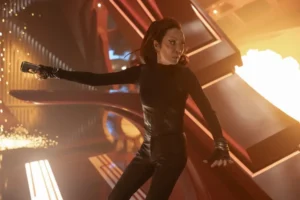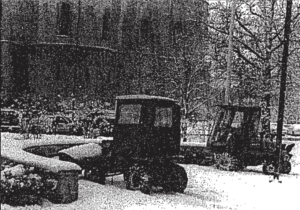Cue to Cue: Making Stage Magic in the Addams Family Musical

Image courtesy of Wikipedia
By Miriam Trujillo
After weeks of preparation, Catholic University’s CenterStage is ready to perform their second to last show of the year: The Addams Family Musical. This past Tuesday, the cast and crew came together from 10:00 a.m. to 7:00 p.m. for their rigorous cue to cue rehearsal. Perhaps the most technically crucial rehearsal in the process of putting on any show, the cue to cue rehearsal, is the time when the whole creative team meets to make sure that every element of the show is present and everything flows together flawlessly.
“We’ve been working in different rehearsal spaces but this week is the first week we’ve been able to get into the actual performance space,” said Julia Williams, a sophomore music theater major who sings and dances in the ensemble. “We have to take as much time as we need to make sure everything looks right, because if it doesn’t look right than it draws the audience’s attention away from the story we are trying to tell.”
Williams also explained that, while the lighting designers can have all their ideas of what they want the set to look like, they are unable to do anything until the actors and costumes go on stage.
The actors were present mostly to demonstrate to the lighting crew where they moved in each scene, allowing the lighting designers to see how their design complements the action. The performers were prepared to pause their lines and entrances any time the director asked. This allowed the lighting crew time to examine the physical layout of every moment in each scene. During these pauses, the crew made sure that their individual lighting choices were feasible in the space they had, seamlessly executed, and emphasized certain characters and moments for a unique visual story. The crew then had to record any changes that they made to the lighting plans, ensuring that they knew which particular lights went with each scene.
“While the lighting designers can have all their ideas of what they kind of want it to look like, they can’t really do anything until they get actors and costumes on stage,” Williams said.
Meanwhile, the costume and prop crews sat in the audience, watching the show’s progress and confirming that every element of the production looked the way it should. The costumers make note of any hemlines that need to be straightened,broken accessories, or any other last minute costume adjustments that must happen before the next rehearsal.
At the same time, the props crew ran through their own cues in which they move each prop, especially chairs, repeatedly, allowing the actors to have everything necessary tell their story. If anything has to be changed during the course of the rehearsal process, the props crew iready to do it.
During the rehearsal, the performers held their places in the middle of lines and gestures, allowing the director and crew to practice and perfect the lighting technicalities. The actors must know their parts thoroughly in order to be able to stop and start without losing their place. They also have to use their own discretion as to how much physical and vocal energy they want to spend during such a long rehearsal, to conserve themselves for the upcoming performances.
In order to have a successful rehearsal, the cast and crew need a lot of patience, enthusiasm, and attention to detail. The reward, however for such a tedious rehearsal is a show where the lights, props, costumes, and movements play off each other like a multilayered dance, giving the audience the false impression that show business is easy, and the result is thrilling.
“[The Addams Family is] just a lot of fun,” said Williams. “It’s funny without trying to be funny. . .I think everybody on stage is just having a lot of fun, and I have a feeling that that will affect the audience.”







